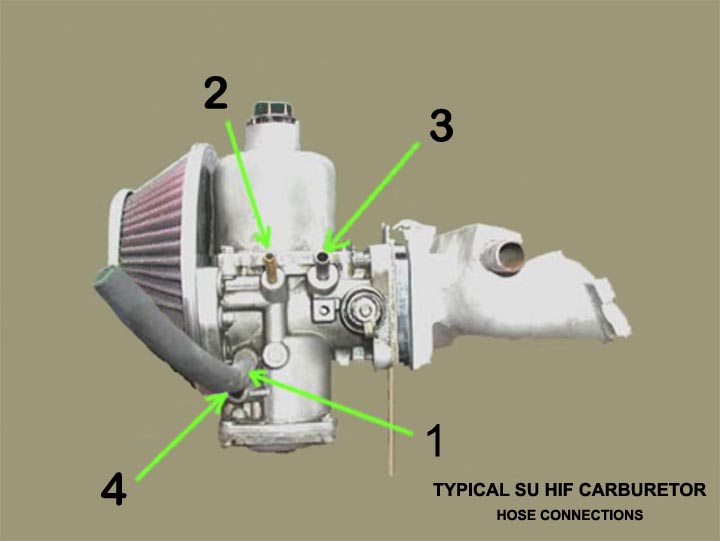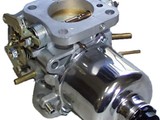Austin Mini Cooper HIF Carb Installation
Although there are a number of different versions of the HIF type carb, they all essentially share the same type of connection layout. The diagram below depicts the most common type - the connections can be on either the right hand side (as illustrated below) or the left hand side. Some have the connections shared on either side. Whichever, the port functions are the same.
It isn't essential the crankcase breather pipe be connected - you really don't want that choking crap from the crankcase spoiling your nice, fresh, fuel-rich incoming mixture - but it's obviously essential to block the port off if you don't. A blob of RTV Silicone is sufficient in most cases.
To adjuster mixture - screw the adjuster in to richen, out to weaken. There may be a 'anti-tampering' cap in there on some carbs - just hook it out.
On some HIF carbs - predominantly used on later Ital (Marina) and Maestro A+ low compression engines - there can be a black hose looped from a port on top of the carb to manifold flange to the float chamber breather/overflow port. This is a leaning-out device for when running at cruising speed on small throttle openings. This needs removing before it's really useful on tuned Minis. Just block the flange-mounted port off, and breath the float chamber to atmosphere as normal.
Unlike the H and HS type carbs, the choke circuit is controlled internally by a special port controlled by a tapered spindle - so there's no messing about with choke linkages needed. Simply connect the cable up.
The standard Mini mechanical fuel pump is more than enough to feed the 1.75" HIF carb up to about 115-120bhp. Outputs higher than this that are to be used at maximum power/rpm for any length of time, it's advisable to think about fitting an electrical pump to ensure constant delivery at max power/high engine speeds. Required pressure is 2.7-3.0psi with a flow-rate in the order of 15-18 gallons per hour. And unless the car is being driven flat out all the time - a pressure regulator is highly advisable to avoid rough-running at idle (caused by over-rich mixture as the carb is shaken about) and flow valve seat damage.
Using pumps that produce higher pressures and flow-rates than this are purely over-kill and will make a regulator an absolute necessity. Get a good quality one as it'll be earning it's living!
1 - FUEL INLET PORT
2 - FLOAT CHAMBER OVERFLOW/BREATER
3 - CRANKCASE BREATHER PIPE CONNECTION
4 - FUEL MIXTURE ADJUSTMENT

Vac pipe take-off -
On some HIF carbs, the vac take-off sighted just after the butterfly - that's between the butterfly and the carb to manifold mounting flange - has been eliminated. Instead, the engines these carbs are fitted to use a vac take off in the manifold. The reason for this is again wholly idle emissions orientated. The higher vacuum that exists in the manifold area can be used to pull more ignition advance. Theoretically this will reduce emissions at idle. Unfortunately it's exposed to induction pulsing. In the A-series, this is UGLY. The pulsing and high manifold vacuum causes rough idling. Particularly where anything 'sportier' (ANYTHING) than a bog-stock-standard cam profile is used.
Classic example - the MG Metro. Its adventurously sporty cam makes for a slightly lumpy idle. This increases idle speed emissions, so Rover use manifold-sourced vacuum to increase idle speed ignition timing via the vac advance. We're talking 28 degrees of ignition timing here! Doesn't work because the pulsing created by the cam causes erratic ignition timing, culminating in running on. So an anti-run-on valve was fitted as a modification. Vicious circle. After messing about trying to solve the emission problems this caused, it was found that changing the originally quoted valve clearances to 0.014"inlet /0.017" exhaust (effectively reducing the cam over-lap) helped dramatically. And, like I said earlier, the sportier the profile, the worse it becomes. Even worse - when running, this system can cause ignition advances in the order of 50 degrees on lift-off and on again - an absolute sure-fire recipe for savage detonation.
The solution is easy - remove the vac take-off from the manifold and fit it back to just in front of the butterfly where it should be. If you need to drill a port to accept the vac pipe take-off it needs to be sited 9/16" back from the carb to manifold mounting face, offset slightly to one side. I.e. NOT at the dead centre, or 'peak' of the butterfly bore. And usually set off away from the crankcase breather port. Usually the vac pipe take-offs fit a 1/8" diameter hole - but measure whatever you're going to use before drilling. You're looking for an interference/air tight fit.









